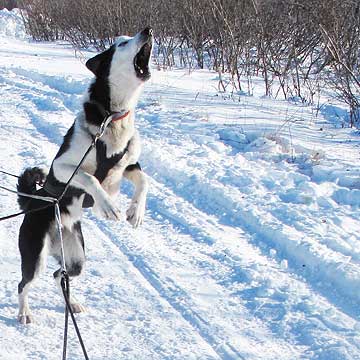
Searching for secrets within the Alaska sled dog
March 16, 2012
“I’m up here about once a month, about half around Anchorage and half around Fairbanks,” the Oklahoma State University veterinarian and exercise physiologist said on the phone from Wasilla. “If I could settle on a single address, I could get a Permanent Fund Dividend.”
Davis was in Wasilla for the start of the Iditarod. There, he cheered on Aliy Zirkle, Martin Buser, Jake Berkowitz, Rick Swenson and other mushers who have over the years entrusted Davis to take blood and muscle samples from their dogs. His goal is to discover the magic within a sled dog that allows it to keep going and going. While we humans tend to fade after exercising just a few hours, sled dogs are somehow able to avoid that crash. “Dogs will go from using their reserves to not in 48 hours,” Davis said. “They gain fitness that fast. Their response is to change their metabolism so they don’t use up their reserves anymore.” Finding the trigger to that change is Davis’s big question. He is funded in part by the U.S. Army Research Office Division of Life Sciences, which is interested in improved performance of human beings. Musher Aliy Zirkle of Two Rivers, runner-up to Dallas Seavey in the 2012 Iditarod, again showcased an amazing ability of sled dogs — a majority of dogs that pulled her from Willow to Nome in 2012 were the same dogs that raced her husband Allen Moore to second place in the Yukon Quest less than three weeks earlier. “They don’t just continue to perform, they perform a lot better,” Davis said of dogs that run both races. “There’s a good argument that nothing prepares a dog better for a 1,000-mile race than a 1,000-mile race. They can do it indefinitely, as long as you have trail and they’ve got food. They get tired, but they don’t fatigue in the biochemical sense.” The key to a sled dog’s endurance is its ability to get energy it can use immediately. Davis and others have found that dogs are much quicker than us at moving energy into their muscles. “The faster you can get stuff into a muscle cell, the faster you can use it,” Davis said. “They may get better at pulling fat out of the bloodstream on the fly.” The key to this ability is in a sled dog’s “transporters,” proteins that allow it to pull carbohydrates and fats through cell membranes and into muscle cells. The proteins we use for that job also exist in dogs, but Davis and other researchers found decreased numbers of the human-style transporters within dogs at a time when the measurements showed the dogs were moving more fat. “Something is transporting the fat into dog muscle, but it isn’t the transporter that we use,” Davis said. The mystery protein that ushers energy molecules across cell membranes might be hiding from researchers not only because it’s different than the one we use, but because it might be so efficient that there are fewer of them to be found. It appears sled dogs are pulling Davis and other physiologists into the frontier of animal performance. “We have to be more creative in our ideas so we don’t miss something,” Davis said. “It’s like a treasure hunt.” Before the 2012 Iditarod was decided, Davis was back in Oklahoma, where he was busy with two tasks. One was analyzing sled dog muscle tissue and other samples so graciously provided by top dog mushers. The other was following the race as most people do. “I’ll have my computer open (to an Iditarod website), hitting refresh every 10 minutes,” he said.
This column is provided as a public service by the Geophysical Institute, University of Alaska Fairbanks, in cooperation with the UAF research community.
E-mail your news &
photos to editor@sitnews.us
|
|||
